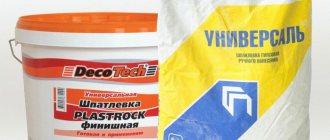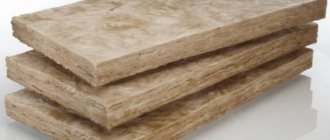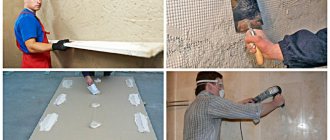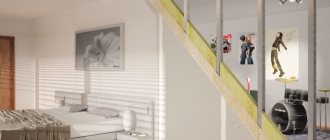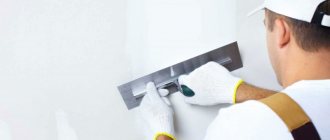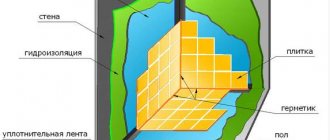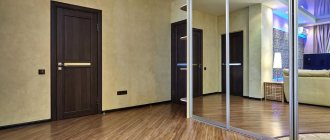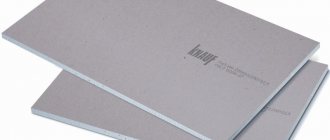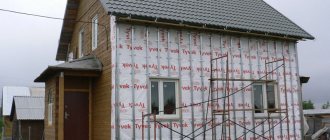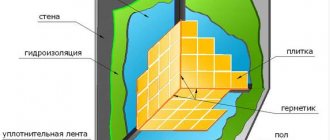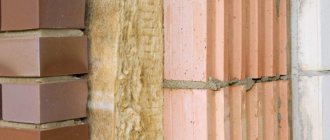The use of thermal insulation solutions in the construction of residential buildings helps preserve heat and comfort, save energy, and increases the service life of the house itself. Creating high-quality living conditions largely depends on the insulation used to insulate the wall. Today the market offers a variety of insulation products and technologies - for wooden, brick, frame houses, for insulation from the outside and from the inside. How to choose the right material – read our review.
Why do you need wall insulation:
Solving the problem of heat loss in the house
Today, most residential buildings in Russia belong to category D, that is, insufficiently efficient in terms of energy consumption.
However, due to high-quality thermal insulation solutions, it is possible to increase the category of the house to B and even to A+. Proper insulation will reduce the heat loss of the building, and hermetically sealed insulation will significantly reduce the cost of heating the house. “The weather in the house” will depend on the thickness of the layer of protective material for the wall and on its properties, which can be calculated in advance: compare the effectiveness of different thermal insulation solutions and clearly see how much heat loss will be reduced in each specific case. Energy efficiency calculators are used for this. The online calculator for calculating thermal insulation ISOVER helps you choose the right insulation in accordance with the type of wall panel construction, find out how much the energy efficiency of your home will increase, and also allows you to purchase the necessary product. To calculate what is needed in each specific case for thermal insulation of a house, apartment, balcony or any living space, the following calculations are carried out: 1. The thickness of the insulation layer largely depends on the climate zone. Each region has its own thermal insulation standards. Therefore, the location is immediately set. For example, Moscow. 2. Next comes the selection of the type and parameters of the object . For example, a house. You will need to set its dimensions and select which surfaces need insulation (walls, roof, ceilings). The calculator will calculate the volume of material required and also suggest the optimal product from the entire line of ISOVER mineral wool; 3. You can then set the desired room temperature . Based on this, the energy efficiency class will be determined and it will be shown how much it will increase after insulation with mineral wool. Here the final calculation will be made - the number of packages, the final price, dimensions for transportation. And the options offered are purchasing online or through regional distributors. CALCULATE HOUSE INSULATION
Maintaining a comfortable temperature
The main function of wall insulation is to provide a comfortable air temperature in the building. A residential building in different rooms, depending on their purpose, must maintain heat from 18 to 25 ° C. This can be achieved thanks to high-quality insulation, and the result depends on the characteristics of the insulation. Properly done thermal insulation of the perimeter of the house and the floors inside it allows you to avoid heat loss and maintain the air inside at an optimal temperature. The material used to insulate the building must meet current requirements and standards for thermal conductivity and safety. You can calculate whether the external partitions of your home provide the necessary thermal protection using the energy efficiency calculator.
Some rules for carrying out thermal insulation work at the dacha
Of course, the price of the material also influences the choice of the type or brand of insulation, but, in addition, it should be taken into account that materials for its installation will also be required, the cost of which can significantly offset the economic benefit of purchasing a cheaper insulator.
Installation of thermal insulation material can be done in different ways, but insulating a house from the inside is best done using special adhesive compositions intended for this type of work, as well as fastening elements: dowels, including umbrella dowels, self-tapping screws and even nails.
But in some cases, this set will not be enough and it will be necessary to construct a sheathing, which not only serves as a basis for laying insulation, but also acts as a ventilation gap to allow condensate to evaporate. In such cases, the use of a vapor barrier film is also required, which simultaneously serves to protect the thermal insulation material from getting wet and to freely drain condensate.
Laying a diffuse vapor barrier film can be done both between the insulation and the outer layer of finishing, and additionally between the outer wall and the heat-insulating material.
The choice of method is determined by the material from which the walls of the house are built, as well as the type of insulation itself.
In some cases, protection from moisture is required not only for the latter, but also for the walls themselves, which may begin to collapse as a result of constant exposure to moisture. This factor is especially important when thermally insulating wooden houses and especially if the walls are insulated from the inside with penoplex - a material with low thermal conductivity, which allows the use of products of small thickness, but with almost zero vapor permeability, which in a particular case can be dangerous for a log house.
Prevention of problems associated with the formation of cold bridges
During work, it is important to correctly lay the thermal insulation material, without allowing even a millimeter of bare wall - neglecting this rule will lead to the formation of cold bridges through which heat will freely flow out and cold air in, and in addition, such places become areas where Condensation actively forms, and then mold appears.
The formation of cold bridges can also be caused by fastening elements, and this is especially noticeable in the example of wooden houses, for which the use of metal parts is undesirable.
If possible, it is recommended to use wooden elements that have the same thermal conductivity, and if it is necessary to use metal ones, insulate the latter, for example, with wooden or plastic parts, as well as with the use of thermal insulation materials.
Selecting insulation for walls according to functional purpose.
Thermal insulation from inside the house.
Wall insulation is installed both outside and inside the building. High-quality thermal insulation can be carried out in both cases, however, experts recommend giving preference to the external insulation option. When thermal insulation is located internally, during periods of negative temperatures both the external enclosing structure and partly the insulating material itself freezes. In addition, conditions arise for the formation of condensation at the boundary between the thermal insulation and the load-bearing wall. Difficulties arise when isolating joints between floors and external enclosing structures - “cold bridges” form at the joints. If, for some reason, it is possible to insulate a house only from the inside, it is necessary to calculate the annual balance of moisture accumulation. And also provide effective ventilation in the rooms and additional vapor barrier between the gypsum building board and the insulation.
Thermal insulation outside the house.
When the insulation is installed from the street side, temperature changes in the wall occur slowly and gradually, and the coldest point is located in the outer layers of the external thermal insulation. In such a wall sandwich, the hard and dense layers face inward, and the soft, porous layers face outward. This improves convection and natural vapor exchange, preventing moisture from accumulating in the thickness of the walls. Additionally, you can insulate the facade with a membrane from rain and snow, then, thanks to the protection of the insulation with a material with hydrophobic properties, the entire structure will retain its characteristics even better. The method of external cladding with thermal insulation material or, in other words, insulating the house along the facades is the best choice for residential buildings.
Conclusion
Among the variety of materials for internal wall insulation, it is advisable to give preference to warm wallpaper, heat-insulating paint and drywall . These options are characterized by ease of use, as well as high thermal insulation and environmental properties.
In any case, when choosing a material, be sure to pay attention to its composition, expiration date and manufacturer.
The following are also suitable as insulation materials:
- penofol;
- penoizol;
- polyurethane foam.
Modern insulation for walls
Today, in the thermal insulation material market, two thirds of the total sales volume is occupied by products based on mineral wool. It deservedly ranks among the most popular and effective insulation options. It has good thermal insulation properties, does not burn, is convenient for installation, economical, and safe for human health and the environment. Mineral wool is made from natural inorganic mineral raw materials - quartz or basalt. Both options for home wall insulation are successfully used in construction work.
Warm plaster
Insulating plaster, characterized by excellent thermal insulation properties and ease of use, is increasingly in demand. It is made from perlite and foam glass . The second option is more preferable for interior work.
It is based on unsorted foam glass granules, due to which this plaster has a number of positive features:
- excellent heat and steam conductivity;
- environmental friendliness;
- durability and strength;
- fire resistance;
- sanitizing properties.
Plaster
Selecting insulation for walls based on the origin of raw materials
ISOVER is the only manufacturer in Russia that produces both types of insulation.
Quartz
Quartz-based wall insulation is one of the most modern and high-quality thermal insulation materials. At ISOVER factories it is made from quartz melt using crimpling - corrugating the structure - resulting in products with increased strength characteristics. And the innovative TEL technology will make it possible to obtain long and especially elastic fibers, which during the production process are placed into slabs and rolls in a chaotic manner. As a result, the material for quartz walls is particularly light, performs the functions of heat and sound insulation better than others, and today is successfully used in both professional and private construction.
Basalt
Basalt wool is a classic solution for thermal insulation. It is made from rock – basalt – at a temperature of 1500 °C. This is a reliable and durable material for walls, roofing and technical communications; it has been used for decades. For walls, basalt insulation acts as heat and sound protection, and increased fire safety makes stone wool in demand in all segments of construction - from residential to office and industrial. Basalt-based insulation is easy to work with, and buildings in which basalt wool is used are safe and efficient to operate.
Foam plastic and penoplex
Both types of material are made from polystyrene foam, but there are some differences between them.
Polystyrene foam is 98% air, lightweight and environmentally friendly . Its main disadvantages are rapid flammability and fragility.
Penoplex is more dense, elastic and durable. It is not subject to rotting and is less flammable.
Foam plastic and penoplex
Selecting wall insulation by packaging type
The form of packaging of the material used to insulate the building also matters. For example, the product range of the leading mineral wool manufacturer ISOVER includes rolls and slabs. Each wall insulation has its own advantages and the choice of a specific material depends on the type of construction, the characteristics of the building and installation conditions.
Rolls
Wall insulation in the form of rolls provides ample opportunities for use during construction work. Long rolls of insulation can be cut to fit any pitch of the sheathing - the elastic material does not crumble or crumble. Rolls are convenient to roll out on horizontal surfaces, so this quartz-based mineral wool is often used to insulate roofing structures and facades of large buildings. Thermal insulation of walls using mineral wool in rolls promotes hermetic installation and is well suited for insulating joints. It covers the gaps without forming “cold bridges”.
Plates
Quartz-based mineral wool slabs are the simplest and most convenient option for insulating the walls of a house. In this case, the work is carried out using small heat-insulating boards, completely ready for installation. Mineral wool material slabs are made according to standard dimensions for lathing made of wooden beams with a pitch of 600 mm. The elastic material allows them to stand upright, eliminating gaps, and does not require additional fixation with fasteners during installation. Laying such slabs can be done alone.
Thermal insulating paint
Paint for insulating walls inside is a relatively new insulating material.
It is a special coating consisting of miniature ceramic and silicone balls filled with vacuum, as well as a latex-acrylic mixture that acts as a binder.
Thanks to the vacuum present inside the balls, heat-insulating paint applied to the inside of the walls acts like a thermos, retaining heat for a long time.
Thermal insulation paint has many undeniable advantages compared to other materials:
- possibility of use in the most difficult to reach places;
- Convenience and ease of application (using a spray gun, brush or roller);
- resistance to rotting and ignition;
- absence of harmful fumes;
- excellent adhesion to various types of surfaces - concrete, metal, plastic, etc.;
- Apply in a thin layer without weighing it down.
CAREFULLY!
Before using this coating thermal insulation, it is necessary to thoroughly degrease and dry the surface.
Thermal insulation paint
Characteristics and properties that you need to pay attention to when choosing insulation for walls.
Coefficient of thermal conductivity
The main functional characteristic of insulation is called thermal conductivity. This is the ability to transfer energy from warmer bodies to cooler ones, and is also one of the most important parameters when calculating on a calculator. The lower this coefficient is for a material, the more reliable insulation from external temperatures it can provide. For example, a layer of high-quality quartz-based mineral wool, even of small thickness, has better protection from cold than solid brick or wooden walls, and its thermal conductivity is in the range of 0.038-0.034 W/(m*K)
Fire resistance
Fire safety is a priority during construction and renovation of residential premises. Insulating material, according to the degree of flammability, can have a category from G1 to G4 - that is, from a strong degree of protection to a relatively weak one, or be non-flammable, then it is marked NG. Here the ability of the insulation to ignite, spread fire and smoke, and form volatile particles is assessed. Thus, all mineral insulation based on ISOVER quartz belongs to the highest category - NG. Plates or rolls of the thermal insulation layer are completely non-flammable and can minimize the risks and destructive consequences of a fire.
Environmental friendliness
The material used to insulate walls in residential premises must be safe for human health and harmless to the environment. This important parameter of insulation is called environmental friendliness. Their natural origin makes them the first choice products from the point of view of ecology and human well-being.
Sound and vapor barrier
Some types of thermal insulation also have the properties of a sound barrier. For example, mineral wool wall insulation, due to the softness of its material, absorbs external noise. The degree of protection here is directly dependent on the thickness of the soundproofing layer. Another important property that insulation must have is vapor permeability, especially for wooden structures. The thermal insulation layer should have a lower vapor permeability coefficient than that of the wall. Then the air exchange in the house will be normal. These requirements are fully met by quartz-based mineral wool products, but even in this case, additional vapor barrier from inside the room is recommended.
Expanded polystyrene
Expanded polystyrene is a gas-filled material produced in the form of granular slabs.
It is often used for internal wall insulation, although, according to professionals, it is more preferable for external decoration.
The advantages of this material include durability, environmental friendliness, light weight, moisture resistance and high thermal insulation properties.
However, it is not without its drawbacks - in particular, such as the lack of fire resistance and the need to use additional fasteners (adhesives or dowels).
Advantages of quartz-based mineral wool for wall insulation.
Comfortable temperature
The advantage of quartz-based mineral insulation is its low thermal conductivity. Thanks to this, reliable insulation from external temperature is created in residential premises. ISOVER mineral wools based on quartz belong to the group of the most effective thermal insulation solutions. Using products made from this material, you can eliminate problems such as freezing in the wall, “cold bridges”, irrational heating of the house and, in some cases, reduce energy consumption by 3 times!
Moisture resistance
In order for the insulation layer to perform its functions well, it must be dry in any weather. Thermal insulation of walls that accumulates moisture or condensation quickly freezes and does not retain heat. To avoid this situation, hydrophobic products are chosen for insulation, for example, ISOVER quartz-based mineral wool. This material does not absorb or absorb water. Thus, the entire structure is provided with additional waterproofing.
Elasticity
Thanks to innovative production technologies - corrugating the structure and creating long flexible fibers - ISOVER mineral wool based on quartz is particularly elastic. To insulate walls with its help, no additional fasteners are needed. The insulation boards are easy to install - they fit into the sheathing, do not slide in the frame between the beams and do not change position for the entire warranty period of the material - 50 years.
Form stability
ISOVER quartz-based insulation boards retain their shape, geometric dimensions and outlines for the entire service life. Insulation of rooms from cold and unwanted noise made using this material is very durable. It does not lose its properties and characteristics: it does not wrinkle, does not crumble or crumble, retains heat and does not absorb moisture. With high-quality wall insulation using quartz mineral wool, gaps in the sheathing and “cold bridges” are completely eliminated.
Ease of installation
ISOVER insulation based on quartz is most suitable for installation by a person without special training and “forgiving” errors on site. The insulation boards are lightweight and easy to grip. You can lay the material into the wall sheathing yourself. At the same time, a well-thought-out packaging system allows you to save on transportation and storage - the design of the packs is designed so that they can be transported in a personal car and unloaded without outside help.
Environmental friendliness
The material of the wall panel for installation in residential premises must meet all standards and requirements for cleanliness and safety. By choosing ISOVER quartz-based mineral wool, the consumer receives not only high-quality thermal insulation, but also products with the highest level of environmental friendliness. Insulation boards and roll mats have been awarded the Eco Material Absolute Plus status - this is the highest rating in all areas - products that are environmentally friendly and absolutely harmless to people and the environment. ISOVER thermal insulation products are used in children's institutions, hospitals, and “green” residential buildings.
Safety
One of the important indicators when choosing thermal insulation is its safety. It should not burn or release harmful substances into the environment. Particularly high demands are placed on insulation for the interior walls of a wooden house.
In this case, varieties such as extruded polystyrene foam or polystyrene foam are not suitable. These are materials that can burn. At the same time, they release harmful substances into the environment that kill faster than fire.
To insulate walls, choose special ISOVER materials based on quartz.
ISOVER Warm Walls Strong
Mineral insulation based on quartz can have special strength and density. For example, ISOVER Warm Walls Strong . Its slabs have increased rigidity for greater stability in the structure and to stabilize loads. Other properties of the material also set it apart from its competitors, including mineral wool-based products:
- , installation time is significantly . It is sold ready for installation in the sheathing, and during the installation process itself it does not change its position, does not move or break. It is fastened by surprise due to elasticity and does not require additional fastenings.
- Easy to use - it forgives installation errors, adapts to structural irregularities, helping to eliminate cracks and gaps at the joints with the frame, does not crumble or generate dust. The slabs are 1 meter long, which makes it possible to work with them alone.
- This wall insulation product has a record thermal conductivity coefficient of 0.034 W/(m*K) - lower than most other mineral wool products. This thermal conductivity allows for high-quality thermal insulation in one or two layers.
- The product ISOVER Warm Walls Strong is easy to transport on your own and significantly saves on delivery and storage. The weight of the package is very small - less than 6 kg for 5 slabs, and the dimensions are only 0.3 m3.
The material is available in various thicknesses:
| Thickness, mm | 50 mm | 100 mm |
| Width, mm | 610 mm | 610 mm |
| Length, mm | 1000 mm | 1000 mm |
| Quantity per package, m2 | 6.1 m2 | 3.05 m2 |
| Quantity per package, m3 | 0.305 m3 | 0.305 m3 |
| Quantity per package, pcs | 10 pieces. | 5 pieces. |
The product is available for the Central Federal District and North-West regions. See all characteristics and price of insulation>>>
Ecowool
Environmentally friendly insulation for walls from inside the house is very popular today. One such material is ecowool. This material consists of natural fibers. To improve its performance, the insulation is impregnated with an antiseptic.
Installation of ecowool is carried out in two ways. In the first case, it is installed on the surface in dry form. The second method involves the use of water, as well as special glue during the installation process.
This material appeared on the construction market relatively recently. He is in demand due to his positive qualities. Its consumption during installation is small. At the same time, the insulation also performs the function of sound insulation.
Ecowool does not emit harmful substances into the environment. It does not cause an allergic reaction. This material is used not only indoors, but also outdoors. It sticks well to walls. If installed correctly, the material will not shrink significantly.
Almost all types of wall insulation from the inside have certain disadvantages. This also applies to ecowool. If the material is not laid tightly enough during installation, it will shrink over time. At the same time, its thermal insulation characteristics will decrease. The stock of material during installation is 25%.
Another disadvantage is the ability of the insulation to accumulate moisture. It will be necessary to install layers of vapor and waterproofing. An additional frame is created for the walls. To fill it with quality material, special equipment is used. It is also worth considering that this material is subject to fire. When installing ecowool using the dry method, you will need to work in a respirator. A lot of dust is generated. If the installation is carried out using the wet method, you will need to wait a long time until the insulation dries.
Liquid ceramic thermal insulation
Liquid internal thermal insulation based on ceramics, made using the most modern technologies, has the following features:
- high level of environmental friendliness, allowing the material to be used in any premises;
- resistance to steam and moisture, ensuring maintenance of performance characteristics even after getting wet;
- long service life (at least 15 years);
- resistance to rodents, insects and ultraviolet rays.
The material is applied to the protected surface at any temperature and has a relatively affordable price. The disadvantages of liquid-ceramic thermal insulation include insignificant noise protection and low resistance to mechanical stress.
How to insulate a frame house with ecowool
To spray on a vertical surface, a wooden frame is usually built to divide the space into narrow segments - pockets.
A layer of vapor barrier is attached to the wooden studs, and then OSB boards (or drywall). The upper part of the wall remains unsewn; ecowool will be installed through the hole.
To obtain a solid array of ecowool, you need to hire specialists with professional equipment. Only machine spraying ensures seamless adhesion of the material.
If this is not possible, you can do the filling yourself, but the quality of the layer will be worse.
Ecowool spraying
The material is poured into a suitable container. Then, using a drill, they “fluff” it. Now ecowool is poured into pockets in the walls manually. The lower layers will compact well under their own weight. But the closer to the ceiling, the more effort you need to make to compact the layer.
You can achieve better results and save a little money if you find a company that offers the rental of blow-opening machines for ecowool and try to use it yourself.

